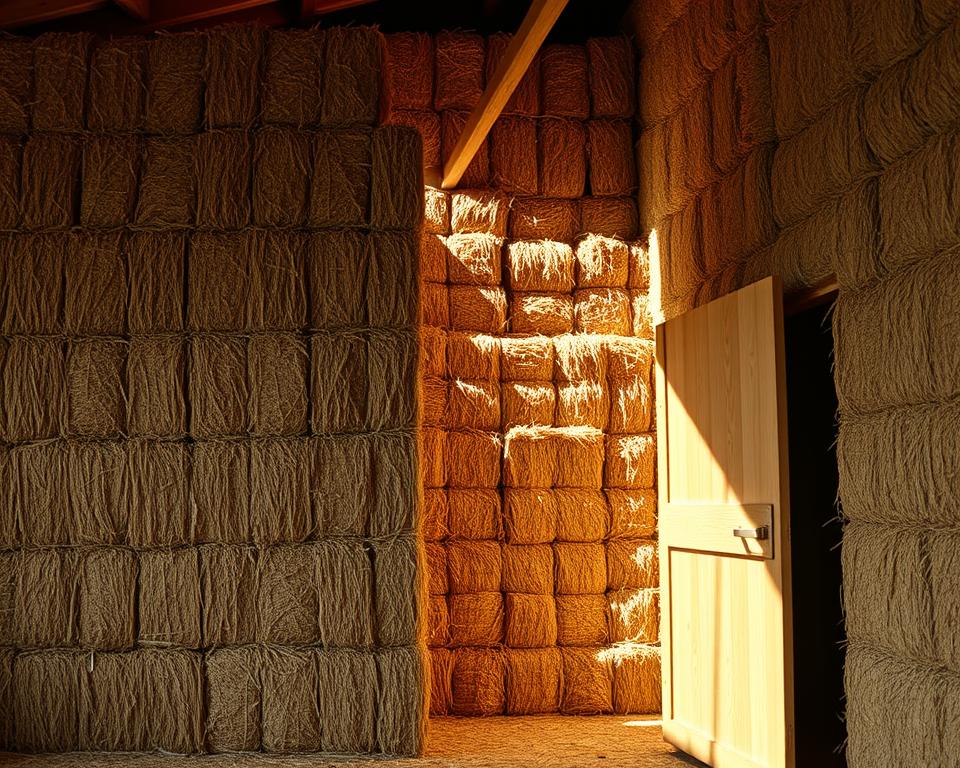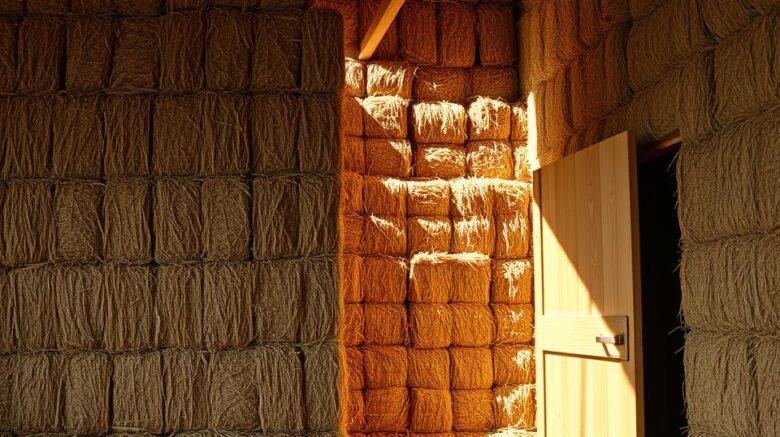Earth Bound Building: Straw-bale Homebuilding in Laurel
Have you heard that houses built with sustainable materials can cut energy costs by up to 50%? It’s one key reason why more homeowners prefer sustainable architecture. Earth Bound Building, serving Laurel, leads this movement, specializing in cutting-edge and low-energy projects.
By using renewable materials including straw bales inside timber frames, Earth Bound Building delivers sustainable residential building Laurel which are both environmentally friendly but also exceptionally durable. Their approach combines traditional craftsmanship with contemporary ecological practices, ensuring every project meets the top standards of sustainability.
What sets Earth Bound Building apart lies in their hands-on approach and deep community involvement. They partner with homeowners to create spaces that reflect their priorities and needs. For those seeking a greener way to build, Earth Bound Building is your go-to partner in Laurel.
Understanding Strawbale Construction?
Straw, commonly considered waste, is revolutionizing green building. Straw-bale methods involves stacking bales inside timber frames to create walls that are simultaneously highly insulating and structural. The technique repurposes an agricultural byproduct, making it a sustainably sourced and eco-friendly choice.
Straw comes from grain crops like wheat, rice, or barley. Rather than burning or discarding it, farmers often provide it for construction. This helps reduce agricultural waste and supplies a sustainable material for homes. The method is straightforward, perfect for owner-builders and community projects.
One of the notable features of straw bale walls is their insulation performance. Relative to traditional materials like fiberglass or wood, straw bales have a higher R-value. This means they hold heat better, producing lower energy costs. Here’s a quick comparison:

| Material | R-Value per inch |
|---|---|
| Straw Bale | R-2.38 |
| Fiberglass | R-2.20 |
| Wood | R-1.41 |
Another advantage is the use of chemical-free materials. Straw bales are absent of harmful chemicals, supporting better indoor air quality. This makes them a sound choice for families and green-minded homeowners.
In summary, straw bale construction is a low-impact, energy-efficient, and health-friendly option. It’s a great match for those aiming to reduce their environmental footprint while benefiting from long-term savings.
Why Select Earth Bound Building for Your Project?
Choosing the right team for your green project matters greatly. Earth Bound Building is a top choice in eco-friendly design, delivering advanced solutions aligned with your needs. Their approach blends leading techniques with a genuine respect for the environment.
Commitment to Sustainability
Earth Bound Building emphasizes sustainable practices in every project. They use carbon-sequestering straw and low-carbon materials to reduce environmental impact. Beyond helping the planet but also supports long-term savings for homeowners.
Their relationships with regional farmers secure ethically sourced materials. By strengthening local agriculture, they reinforce a circular economy. This commitment to sustainability differentiates them in the industry.
Local Expertise in Laurel
With strong connections in Laurel, Earth Bound Building knows the unique needs of the area. They are familiar with local climate conditions, permitting processes, and supply chains. This expertise supports smooth project execution and compliance with regulations.
Their site-specific designs honor Laurel’s aesthetic preferences while complying with strict building codes. Whether it’s a residential or commercial project, they deliver results that harmonize with the local environment.
| Category | Earth Bound Building | Typical Approaches |
|---|---|---|
| Material Sourcing | Local, ethically sourced straw | Imported, high-embodied energy materials |
| Energy Efficiency | High R-value insulation | Standard insulation |
| Environmental Impact | Low carbon footprint | Higher emissions |
Earth Bound Building’s commitment to sustainability and local expertise makes them the ideal choice for your next project. Their progressive practices and community-focused approach deliver a seamless and eco-friendly experience.
The Advantages of Straw-bale Building Laurel
Green building is gaining traction for its ability to combine innovation with environmental responsibility. One of the most promising methods in this field is the use of straw bales. This approach offers a range of benefits, from energy efficiency to eco-friendliness, which makes it an attractive option for modern homeowners.
Energy Efficiency and Cost Savings
Straw bale walls offer exceptional insulation, surpassing traditional materials like fiberglass. With an R-value of 2.38 per inch, they help stabilize indoor temperatures, cutting the need for heating and cooling. This can lead to energy savings of as much as 50–75%.
Over time, these savings can offset the initial construction costs. Homeowners gain lower energy bills while supporting a greener planet. Here’s how straw bales compare to other materials:
| Material | Thermal R-Value/inch |
|---|---|
| Straw Bale | R-2.38 |
| Fiberglass | R-2.20 |
| Wood | R-1.41 |
Eco-Friendly and Renewable
Straw is a annually renewing resource that regrows annually, unlike timber, which requires decades to grow. Using straw in construction lowers agricultural waste and fosters a circular economy. It also stores CO₂ in the walls, contributing to fighting climate change.
Additionally, straw bale walls are low-toxin, improving indoor air quality. They are also resistant to fire, with plastered walls meeting and surpassing 2-hour fire ratings. This makes them a safe and eco-friendly choice for any project.
By choosing straw bale construction, you’re creating more than a dwelling—you’re investing in a more wholesome, more sustainable future.
How Strawbale Homes Are Constructed
There are several ways to create sustainable homes using straw bales. Each method provides unique benefits, from structural support to efficient installation. Understanding these approaches can help you choose the best approach for your project.
Nebraska Style vs. In-Fill Wall Systems
The Nebraska Style is a traditional method where straw walls serve as the primary structural support. This approach is ideal for smaller homes and focuses on simplicity. The bales are stacked directly on the foundation, removing the need for additional uprights or frames.
In contrast, In-Fill Wall Systems use timber frames to take the structural load. The bales are installed within these frames, enabling faster roof installation and broader design flexibility. This method is preferred for larger projects where customization is key.
Prefabricated Straw Wall Panels
Prefabricated panels are a next-gen innovation in straw bale construction. These factory-built wall sections minimize on-site labor and lower weather-related risks. They are designed for quick assembly, making them a practical choice for time-sensitive projects.
Here is a comparison of the three methods:
| Method | Highlights | Ideal For |
|---|---|---|
| Nebraska Style | Load-bearing bales, simple method | Small homes |
| In-Fill Systems | Timber frames, design flexibility | Larger projects |
| Prefabricated Panels | Factory-built, reduced assembly time | Quick installations |
Each method has its strengths, and the choice depends on your project’s needs. Whether you prefer traditional techniques or modern innovations, straw bale construction offers a sustainable and time-savvy solution.
Common Myths About Straw bale Construction
Many people have misconceptions about sustainable materials like straw. These myths often discourage homeowners from exploring eco-friendly options. Let’s clear up some of the most common concerns.
Fire Resistance and Safety
One of the biggest myths is that straw is a fire hazard. In reality, compressed bales lack the oxygen needed to burn. Lab tests indicate that plastered straw walls can withstand 2+ hours of fire exposure. This surpasses the fire resistance of many traditional materials like timber.
Plaster acts as a protective barrier, encasing the bales and preventing ignition. This keeps straw-based structures very safe. Below is a quick comparison:
| Material | Fire Resistance |
|---|---|
| Straw (plastered) | 2+ hours |
| Wood | 1 hour |
Pest and Moisture Management
Another concern is pests. Straw has zero nutritional value, so it doesn’t attract rodents and insects. When finished with plaster, it becomes extremely difficult for pests to penetrate. This neutralizes one of the most common concerns homeowners worry about.
Moisture is also addressable with proper design. Elevated foundations, wide eaves, and permeable finishes such as vapor-permeable stucco prevent rot. Modern techniques support that these homes remain durable for decades.
See how straw compares to traditional materials in moisture control:
| Assembly | Moisture Resistance |
|---|---|
| Straw with Proper Design | High |
| Wood without Treatment | Low |
By countering these myths, it’s clear that straw-based structures are a sound, responsible, and durable choice for modern homes.
Is a Straw bale Home Right for You?
Designing a home that’s both appealing and green is easier than you think. With unique features such as thick window niches and curved designs, eco-friendly homes provide endless possibilities. Let’s explore why this is the perfect choice for you.
Customization and Aesthetic Appeal
One of the defining features of these homes is their design flexibility. You can create sculptural walls, arched doorways, and built-in shelving to suit your style. The thick walls also deliver great acoustic privacy, reducing outside noise significantly.
Rustic plaster finishes bring a unique charm, combining modern aesthetics with natural elements. Whether you’re an artist or an eco-conscious family, these homes can be crafted to express your personality and needs.
Long-Term Benefits and Sustainability
Opting for a sustainable home isn’t just about the environment—it’s also a savvy financial decision. These homes require minimal maintenance over time, thanks to their energy efficiency. With reduced heating and cooling bills, you’ll see significant savings on utilities.
Additionally, green homes can receive tax incentives and tend toward higher property values. Below is a quick comparison of lifecycle costs:
| Aspect | Strawbale Homes | Traditional Homes |
|---|---|---|
| Energy Costs | Lower | Higher |
| Upkeep | Minimal | Regular |
| Resale Value | Higher | Standard |
Earth Bound Building’s discovery process ensures your goals align with your budget. Whether you’re planning an off-grid retreat or a family home, they’ll guide you every step of the way.
In Summary
Embracing eco-friendly living starts with the right materials and the right team. Straw bale homes deliver unmatched benefits, from energy efficiency to resilience. They reduce costs while helping the environment, making them a smart choice for modern homeowners.
Earth Bound Building is a leader in sustainable building in Laurel. Their expertise guarantees every project meets the top standards of quality and sustainability. Choose to join the growing community of homeowners who’ve chosen this innovative approach.
Ready to take the next step? Speak with Earth Bound Building for a tailored consultation. Attend their workshops or tour completed projects to see the benefits firsthand. Building with straw not only builds a home but also strengthens regenerative agriculture and local economies.
